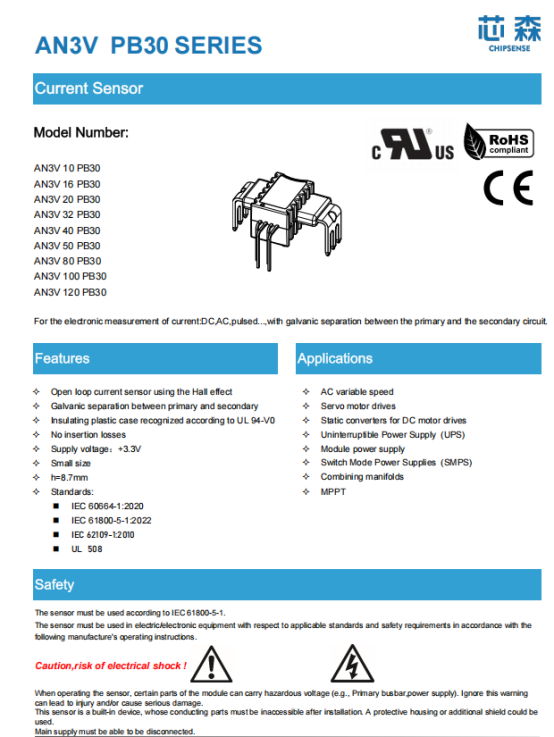
Driven by the "dual carbon" strategy, a large industrial and commercial photovoltaic energy storage project in Shenzhen recently announced the full adoption of CHIPSENSE current sensor AN3V series of high-precision current sensors independently developed by CHIPSENSE, becoming a benchmark case of domestic sensor technology replacing imports. This choice is not only due to the reliable performance of CHIPSENSE products in extreme environments, but also because of its technological innovation to provide a new solution for the efficient operation and safe management of industrial and commercial energy storage systems.

Project challenge: The need for accurate monitoring in complex scenarios
As the first "photovoltaic + energy storage" integrated demonstration project in Shenzhen, its core goal is to achieve a 30% reduction in the park's electricity cost and an increase in the green electricity consumption rate to 80% through the collaboration of 10MW distributed photovoltaic power generation and energy storage system. However, the hot and humid climate in Shenzhen, the rapid fluctuation of the photovoltaic series current, and the need for accurate management of the charge and discharge of energy storage batteries pose a triple challenge to the sensor:
High precision: current monitoring error should be less than 1% to ensure optimal energy scheduling;
Strong anti-interference: it needs to operate stably under a wide temperature range of -40℃~105℃ and strong electromagnetic interference;
Fast response: microsecond dynamic tracking capability to avoid security risks caused by system delay.
CHIPSENSE current sensor AN3V series: Four dimensional technology breakthrough
Hall open loop technology, breaking through the precision ceiling
Using the Hall effect open-loop design, CHIPSENSE current sensor AN3V series still maintains the basic accuracy of ±1% at -40℃~105℃ (nonlinear error ≤0.5% at room temperature). Taking AN3V 20 used in the PV series branch in the project as an example, its ±50A measurement range and 0.5% error rate ensure that the MPPT algorithm tracks the light change in real time, and the photovoltaic power generation efficiency is increased by 12%.

Microsecond response, build a secure line of defense
With a 250kHz bandwidth and 2.5μs tracking time (@90% rated current), CHIPSENSE AN3V 50 captures instantaneous fluctuations in 125A current in real time, triggering a millisecond protection mechanism in the event of an overload or short circuit. Combined with the theoretical gain of 6.667mV/A (AN3V 120 model), the system quickly identifies class 300A abnormal currents and improves the response speed to safety hazards to the industry leading level.
Localization reduces costs and flexibly ADAPTS to all scenarios
Compared with imported similar products, the cost of AN3V series is reduced by more than 40%, and covers the full range of ±10A~±300A. For example,CHIPSENSE AN3V 80 used in the energy storage inverter is compatible with multi-brand equipment in the ±200A measurement range, saving the initial investment of more than one million yuan in a single project.
Measured data: from technical parameters to commercial value
Efficiency jump: photovoltaic inverter conversion efficiency reached 98.5%, energy storage system cycle efficiency exceeded 95%;
Cost optimization: operation and maintenance manpower reduced by 30%, equipment failure rate decreased by 45% year-on-year;
Safety upgrade: Leakage detection accuracy up to 0.01A, overload protection response time reduced to 1.2ms.
How can sensors reshape the future of energy?
"The success of CHIPSENSE current sensor AN3V series stems from the ultimate pursuit of the iron triangle of 'precision - speed - reliability'," said the technical director of CHIPSENSE. This series not only passed a number of international certifications such as IEC 61800-5-1, but also innovatively adopted the original side row design of copper tin plating to control the temperature drift coefficient of resistance at 0.21mΩ~0.29mΩ (-25℃~105℃), which solves the pain point of the industry from the material level.
In the future,CHIPSENSE plans to implant AI algorithms into the edge of sensors to achieve "predictive maintenance" of photovoltaic energy storage systems. Through the linkage with the cloud management platform, further reduce the LCOE (levelized KWH cost) to help industrial and commercial users transition to zero-carbon operations.
Conclusion
In the second half of the new energy revolution, sensors have moved from "behind-the-scenes components" to the front, becoming the "sensory nerve" of the energy system. With CHIPSENSE AN3V series, CHIPSENSE proves that domestic technology can not only break the import monopoly, but also redefine the industry standard with innovation.
CHIPSENSE photovoltaic current detection application cases CHIPSENSE is a national high-tech enterprise that focuses on the research and development, production, and application of high-end current and voltage sensors, as well as forward research on sensor chips and cutting-edge sensor technologies. CHIPSENSE is committed to providing customers with independently developed sensors, as well as diversified customized products and solutions.
“CHIPSENSE, sensing a better world!
www.chipsense.net
4F, Building C, ZHENGLING.Hi-TECH PARK(Core Space) , No. 2 Cuizhu 2nd Street, Xiangzhou District, Zhuhai, Guangdong Province, China
+86-756-8600806